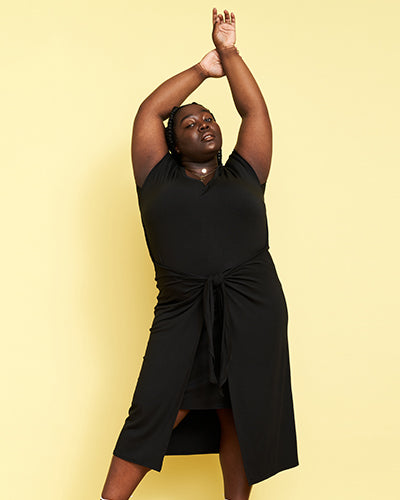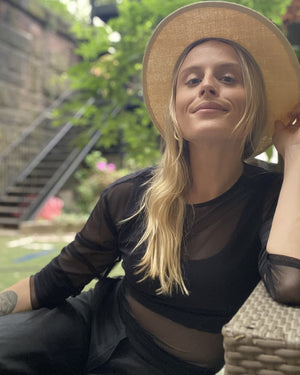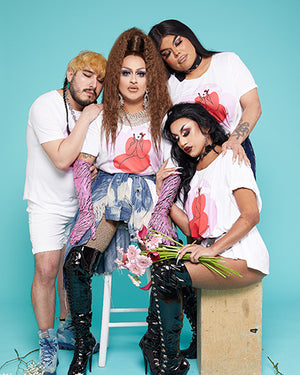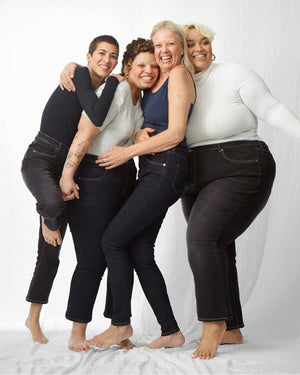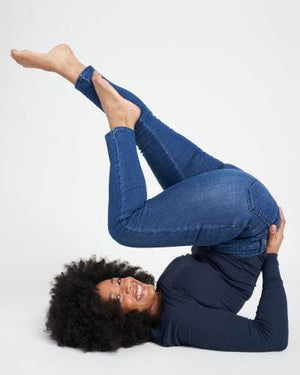
A Conversation About Creativity and Blackness in Fashion
Universal Standard Creative Director of Brand & Image Henrietta Gallina
interviewed by
Editorial Director Amanda Richards
The thing about Universal Standard campaign imagery — Foundation, Rodarte x Universal Standard, and our subway campaign, to name a few — is that it sticks with you. When I was working in publishing, I remember seeing the press releases for those campaigns come through my inbox, and every single time, the imagery stopped me in my tracks. It’s simple; sometimes even minimal. But somehow, each image tells a story, all on its own. I didn’t know it back then, but every single one of those images started with an idea, one from the mind of Universal Standard Creative Director Henrietta Gallina.
And now, luckily enough for me, I work right next to her.
After 15 years in fashion brand marketing, Gallina has developed a creative perspective that’s both otherworldly and utterly terrestrial; her work is about finding the power in regularity, the beautiful in the ordinary. As one of a woefully small amount of black creatives in the industry, she also has plenty to say about what it’s taken her to get to this point — and how she wants to see the fashion industry continue to make space for blackness in the future.
Amanda Richards: I don't know anything about your career, really. Like how you got started, where you went to school, how you got interested in fashion. I don't know about anything you did before this.
Henrietta Gallina: There was literally nothing before this, or before you.
AR: There will be nothing after, either.
HG: I feel like I've always done this. I grew up loving fashion and loving art. I always knew I was going to work in fashion in some capacity. I just didn't always know what it was. When I went to school, I always focused on those more creative topics, like textiles and art. I didn't finish my degree, but I went to Central Saint Martins, did a Foundation and started a BA. When I left college I just interned at a bunch of places — at magazines, at PR agencies, in retail, like just did a bunch of things.
AR: How did you make money, interning so many places?
HG: I worked in retail for a long time, actually, while I interned. And then one of my internships turned into a full-time job. They created a marketing assistant role for me at Fred Perry. That's literally how I got my start in marketing. It was the most interesting part of fashion for me, because it was this cross section of everything from image making, content creation, advertising, brand strategy, retail. It felt like it touched all of these different interesting facets of the brand, from design, to out-of-home, to experiential. It was brand marketing, to be clear — marketing is very different today. When I started out, it was more about big ideas and creative strategy, brand ideals, and executing against all those things. It was really exciting. It was before social media was so prevalent, so it was also concepting traditional campaigns, building physical out of home experiences and connecting people in cool spaces.
AR: So you started at Fred Perry, and then what?
HG: Then I went to TopShop, moved to New York, and then just freelanced for a bunch of brands including TopShop and Fred Perry. Then I went to the agency side — I went to an agency called Alldayeveryday. They were not conventional and led with culture and had a great point of view, and that’s why brands went to them. We did internal programming and original content, which was fun. We did our own parties, the news stand at the Lorimer street subway station (which ended up in the MoMA), a book with Glen O'Brien — just cool campaigns where we had the freedom to create what we wanted. I think it taught me a lot about what happens when you lead with culture.
AR: Where did you work right before coming to Universal Standard?
HG: I was at Karla Otto, which was, like, super luxe. And gave me really good experience working in luxury fashion, which is a whole other ballgame. I was in awe of her. She helped to build brands like Jean Paul Gaultier, and was one of the first PR people to work with Prada, Marni, Jil Sander and Old Celine. She's that legacy kind of old world luxury, which I think still has a lot of relevance and currency today. Those brands are decades old and still carry a lot of weight. There was a lot to be learned from someone like her. But luxury, for the most part, is so late. So it was a bit of a double-edged sword.
AR: So as you were moving through your career and working in all of these different places and learning from all of these different people, did you have other black creatives to look up to?
HG: No. Definitely not internally. I feel like every job I've ever had, even to this day, I was one of the only black people or POC — if not in the company, definitely in the department. Which is sad, because I think that it's just been so normalized that it's not necessarily the first thing I think of when I enter a workspace. But the idea of “blackness in fashion” has become so prevalent, you can't help but wonder why the internal workings look so different to what’s projected externally. It's something I think about a lot now. I never used to because before, because it was just the status quo. I think fashion's current obsession with blackness is really interesting, because I'm not quite clear what the motives are or where the ideas come from. Other than the obvious — trying to acquire the black dollar. But when you look at a lot of the brands trying to show a lot of support for the black community, I just find it really interesting when that's just not reflected in the culture inside the company.
AR: So if there are no black creatives working behind the scenes, where do those ideas come from?
HG: I’ve been that black creative voice at companies I work for, and I am at Universal Standard, so for me, personally, it doesn't feel like such a tenuous link — there’s a genuine connection there, between me and the idea. I’m from an African family; I’m used to seeing different bodies. I grew up in London in a very multicultural environment. I moved to New York, another very multicultural environment, different races, people across the sexual and gender spectrum is the norm for me. I'm just reflecting what I know. But at other places where there aren’t any black creatives — I sometimes wonder how genuine the ideas are. It's always hard to understand motives when there's not that genuine connection. And in fashion generally, unfortunately, that's just the norm. You'd be hard-pressed to find somewhere that has more than a handful of black people or POC.
AR: So why Universal Standard?
HG: Honestly, the mission. I definitely was very much over fashion. When I left Karla Otto, I was considering just getting out of fashion altogether. I just didn't feel like it was a place that was for me. I’m not naturally an extrovert, and when you’re not, it’s hard to network and interface in spaces that you don't necessarily feel are for you. Also it was just really hard to try to get my ideas across to people, who just didn't understand. In luxury specifically, you're talking to a lot of older white men and trying to get them to understand a point of view that is just so natural for you, but not for them. After a while it becomes very frustrating. And then just the way that fashion is set up with sample sizes and the model archetype, that's like a very thin Western ideal of beauty. Trying to get people to deviate away from those ideals that have been so calcified over decades, centuries even, just honestly got quite exhausting. Universal Standard felt like a completely different idea of fashion. It definitely felt progressive and what I always had hoped fashion could be. So I was really excited to help further that mission and actually bring my ideas to the table.
AR: Do you feel like you've done that?
HG: I think I've made some headway, for sure. I think the company looks very different since I've started and I don't actually necessarily think it's because I'm black. I think it's because I have a bit of a different point of view on fashion, generally. I'm proud of everything I've done so far. And I'd like to think it should be an example of what's possible. In fashion, we pigeonhole so much — models, and what you can and can't say. And brands put statements out that often don't feel very real. So I'm proud we've somewhat moved the needle to represent a bit more of an honest cross-section of people who get to be seen in these spaces.
AR: I want to go back to something you said before — about how no matter if you’re on the agency side, or working for a brand, or designing — the whiteness is real. After 15 years of that, there had to have been challenges navigating these spaces. What are they? How did you deal with them? What did you learn?
HG: So, this is just my personal perspective — I always worry that because there are so few of us, people seem to think we speak for all black people. It's like anything else, blackness is a spectrum and doesn’t look or think like any one thing. But for me personally, the challenges are always the things that other people don't see because they can't, or they don't have to, or it just wouldn't occur to them. And I think that has always been a challenge for me. So I often get that like, "She's overreacting." Or "Oh, she's got an attitude." Or “What does that even mean?” And sometimes you just want someone else there with you who gets it to be like, "Did you hear that?" Or, "Can you believe that?" Or, “Did she actually just think I was that person?" It almost feels like these invisible problems that ultimately end up sometimes making you look like the problem. Having to navigate that is always tricky, because you want to be professional and you're in a professional setting, trying to get along and get ahead. And upward mobility is challenging enough for women, for people generally as it is, especially in competitive cities like London and New York. So it's like you're constantly kind of running into this battle of, "Shall I speak up? Shall I sit back?" And then there's more context there because you're like, "If I do speak up, or advocate my opinion, are they actually going to hear me? Or are they just going to hear black aggression?" Plus it's also creative work that you really care about, which is all completely subjective, and how you are perceived does often impact how your work is received. It’s a lot. And you can spiral, genuinely.
AR: Do you think the blackness that the fashion industry loves to commodify will ever be reflected internally? How do you see the future of the industry evolving?
HG: I'm actually really optimistic because I think it has to change. I don’t think that fashion's obsession with blackness is a trend. That whitewash that happened in the ‘90s? There's no way that can happen again, not with social media and having so many prominent black voices in the mix. It’s incumbent on brands to hire people that reflect the people that they claim to support. And I don't think that's just about blackness. I think it's about the LGBTQ+ community. I think it's about women. I think it's about differently-abled people. I think it's across the spectrum of marginalized people. I just don't see how you can be a current, progressive, interesting brand, and not have those people work for you. It makes no sense. And I know that some of my friends think I'm naive, because there’s no real way to accurately monitor the internal workings or hiring practices of companies, but I just don't see how this could continue. It's just good business. And ultimately, fashion always follows two things — money and culture. So I think that having more diverse voices at the table would just create better brands, which will in turn generate more money.
AR: So you’re optimistic.
HG: I'm very hopeful, because there's never been a better time to be a black creator in fashion. And I think people should acknowledge that. Look at the amazing creatives we work with from Ronan McKenzie and Travis Matthews to Gabriella Karefa-Johnson. Look at all of these amazing stylists, makeup artist, image makers, writers, designers that are coming up, there are more black models than ever before at the forefront of campaigns and shows. I think it's a really exciting time to be black in fashion, and that has to be integrated internally. And I think that if your eyes aren't open to that, you will be shook.
